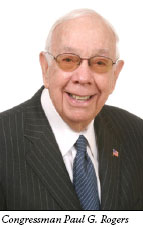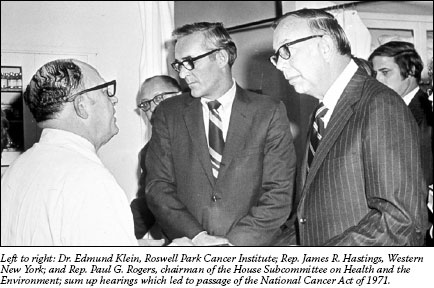
Remembering a Leading Advocate for Cancer Research
Last week the country lost a true champion of biomedical research and proponent of quality medical care for every American. Former Congressman Paul G. Rogers, one of the principal leaders in the development and passage of the National Cancer Act of 1971, died on October 13. He was 87.
 I can only imagine that as a young man whose formative experiences included serving in the U.S. armed forces during World War II - for which he received the Bronze Star - Congressman Rogers could not have foreseen that he would become one the most prominent and well-respected voices in support of biomedical research and health care our country has ever known. I can only imagine that as a young man whose formative experiences included serving in the U.S. armed forces during World War II - for which he received the Bronze Star - Congressman Rogers could not have foreseen that he would become one the most prominent and well-respected voices in support of biomedical research and health care our country has ever known.
Even as he began the first term of an illustrious 24-year career as a member of the U.S. House of Representatives, he could not have anticipated that he would be honored by organizations like the American Cancer Society, the National Osteoporosis Foundation, and the Lasker Foundation; or that he would be elected to such prestigious organizations as the Institute of Medicine; or that he would have a plaza on the NIH campus named in his honor.
But if his actions are any indication, he truly lived his public life by his own words, which are now inscribed on a plaque in the Paul G. Rogers Plaza on the NIH campus: "Without research, there is no hope."
Congressman Rogers' accomplishments are both legion and legendary. During his 8-year tenure as chair of the House Subcommittee on Health and the Environment, he ushered through the passage of the Health Manpower Training Act; National Heart, Blood Vessel, Lung, and Blood Act; Safe Drinking Water Act; and Community Health Centers Act, just to name a few. As these laws demonstrate, although Congressman Rogers believed in the power of research, he also knew that maintaining and improving public health extended well beyond the walls of the laboratory.
Congressman Rogers was committed to ensuring that research being done at government and large academic centers was translated and delivered to the communities where most people receive their care. As he recounted in the NCI Cancer Bulletin nearly 2 years ago, among the most important provisions in the National Cancer Act were those that established the Cancer Centers Program. The continued growth of that program is a testament to Congressman Rogers' foresight and wisdom as a policy maker. The launch last year of the NCI Community Cancer Centers Program pilot is, in many ways, an extension of Congressman Rogers' fundamental belief in the importance of ensuring the translation and delivery of cutting-edge cancer care to patients where they live.

Congressman Rogers was prescient about the challenges of making quality medical care, including cancer care, available to every American, regardless of race, culture, or socioeconomic status. In a 1991 interview, he talked about the need to address the growing number of Americans without health insurance or without "adequate access to the [health care] system." He also spoke about the growing burden of the escalating cost of care. Both are issues we are still trying to come to grips with today.
Indeed, in a 1979 interview, the year he left public office, he spoke of what drove his legislative efforts in health care. "I saw the potential for what could be done…and it was just not being aggressively pursued," he said. "We were not looking ahead and planning."
As a legislator, a policy maker, a mentor, and a public health leader, Congressman Rogers' efforts have had a profound impact on biomedical research and medical care in the United States. His tireless efforts, it can be safely said, have helped build infrastructure and establish policies that will ensure continued progress for years to come.
I have lost a friend and mentor. Paul was among the first to welcome me to Washington, D.C., and to my new position at NCI. He was eager to introduce me to his many friends and was always full of encouragement whenever our paths crossed. He never saw me without saying, "We have to get you more money to do your job." He understood the importance of our nation's investment in biomedical research. I will remember his gracious manner and will do my best to follow the high standards he set for all of us.
Dr. John E. Niederhuber
Director, National Cancer Institute
|